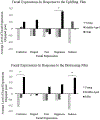Responding to the emotions of others: Age differences in facial expressions and age-specific associations with relational connectedness
- PMID: 30730167
- PMCID: PMC12320614
- DOI: 10.1037/emo0000534
Responding to the emotions of others: Age differences in facial expressions and age-specific associations with relational connectedness
Abstract
Responding prosocially to the emotion of others may become increasingly important in late life, especially as partners and friends encounter a growing number of losses, challenges, and declines. Facial expressions are important avenues for communicating empathy and concern, and for signaling that help is forthcoming when needed. In a study of young, middle-aged, and older adults, we measured emotional responses (facial expressions, subjective experience, and physiological activation) to a sad, distressing film clip and a happy, uplifting film clip. Results revealed that, relative to younger adults, older adults showed more sadness and confusion/concern facial expressions during the distressing film clip. Moreover, for older adults only, more sadness and fewer disgust facial expressions during the distressing film clip were associated with higher levels of relational connectedness. These findings remained stable when accounting for subjective emotional experience, physiological activation, and trait empathy in response to the film clip. When examining the uplifting film clip, older adults showed more happiness facial expressions relative to younger adults at trend levels. More facial expressions of happiness were associated with higher levels of relational connectedness, but unlike the effect of sadness expressions, this was not moderated by age. These findings underscore an important adaptive social function of facial expressions-particularly in response to the distress of others-in late life. (PsycINFO Database Record (c) 2019 APA, all rights reserved).
Figures



Similar articles
-
Sexual Harassment and Prevention Training.2024 Mar 29. In: StatPearls [Internet]. Treasure Island (FL): StatPearls Publishing; 2025 Jan–. 2024 Mar 29. In: StatPearls [Internet]. Treasure Island (FL): StatPearls Publishing; 2025 Jan–. PMID: 36508513 Free Books & Documents.
-
Facial emotion identification in early-onset and first-episode psychosis: a systematic review with meta-analysis.Schizophr Res. 2014 Oct;159(1):62-9. doi: 10.1016/j.schres.2014.07.049. Epub 2014 Aug 30. Schizophr Res. 2014. PMID: 25178803
-
Development and Validation of the Children's Emotions Database (CED): Preschoolers' Basic and Complex Facial Expressions.Children (Basel). 2025 Jun 21;12(7):816. doi: 10.3390/children12070816. Children (Basel). 2025. PMID: 40723010 Free PMC article.
-
The significance of mothers' neural responding to infant emotional cues for caregiving behaviors: The moderating role of infant temperamental distress.Dev Psychol. 2025 Jul;61(7):1384-1396. doi: 10.1037/dev0001852. Epub 2025 Jan 9. Dev Psychol. 2025. PMID: 39786797
-
How lived experiences of illness trajectories, burdens of treatment, and social inequalities shape service user and caregiver participation in health and social care: a theory-informed qualitative evidence synthesis.Health Soc Care Deliv Res. 2025 Jun;13(24):1-120. doi: 10.3310/HGTQ8159. Health Soc Care Deliv Res. 2025. PMID: 40548558
Cited by
-
Increasing empathic concern relates to salience network hyperconnectivity in cognitively healthy older adults with elevated amyloid-β burden.Neuroimage Clin. 2023;37:103282. doi: 10.1016/j.nicl.2022.103282. Epub 2022 Dec 6. Neuroimage Clin. 2023. PMID: 36525744 Free PMC article.
-
Emotional and Cognitive Empathy in Caregivers of Persons with Neurodegenerative Disease: Relationships with Caregiver Mental Health.Clin Psychol Sci. 2021 May 1;9(3):449-466. doi: 10.1177/2167702620974368. Epub 2021 Mar 19. Clin Psychol Sci. 2021. PMID: 34194871 Free PMC article.
-
Physiological, behavioral and subjective sadness reactivity in frontotemporal dementia subtypes.Soc Cogn Affect Neurosci. 2019 Dec 30;14(12):1453-1465. doi: 10.1093/scan/nsaa007. Soc Cogn Affect Neurosci. 2019. PMID: 31993653 Free PMC article.
-
Stress and Illness: A Role for Specific Emotions.Psychosom Med. 2019 Oct;81(8):720-730. doi: 10.1097/PSY.0000000000000736. Psychosom Med. 2019. PMID: 31343581 Free PMC article.
-
Social Functioning in Individuals Affected by Childhood Maltreatment: Establishing a Research Agenda to Inform Interventions.Psychother Psychosom. 2022;91(4):238-251. doi: 10.1159/000523667. Epub 2022 Apr 5. Psychother Psychosom. 2022. PMID: 35381589 Free PMC article. Review.
References
-
- Batson CD (2011). Altruism in humans: Oxford University Press.
-
- Cacioppo JT, Hawkley LC, Kalil A, Hughes ME, Waite L, & Thisted RA (2008). Happiness and the invisible threads of social connection. New York: The Guilford Press.
-
- Cacioppo JT, Hughes ME, Waite LJ, Hawkley LC, & Thisted RA (2006). Loneliness as a specific risk factor for depressive symptoms: cross-sectional and longitudinal analyses. Psychology and Aging, 21(1), 140–151. - PubMed
-
- Campos JJ, Campos RG, & Barrett KC (1989). Emergent themes in the study of emotional development and emotion regulation. Developmental Psychology, 25(3), 394–402.
-
- Carstensen LL (1992). Social and emotional patterns in adulthood: support for socioemotional selectivity theory. Psychology and Aging, 7(3), 331–338. - PubMed

